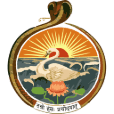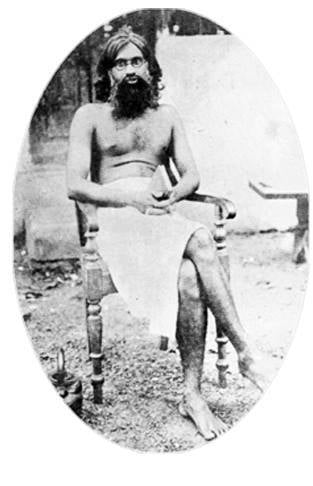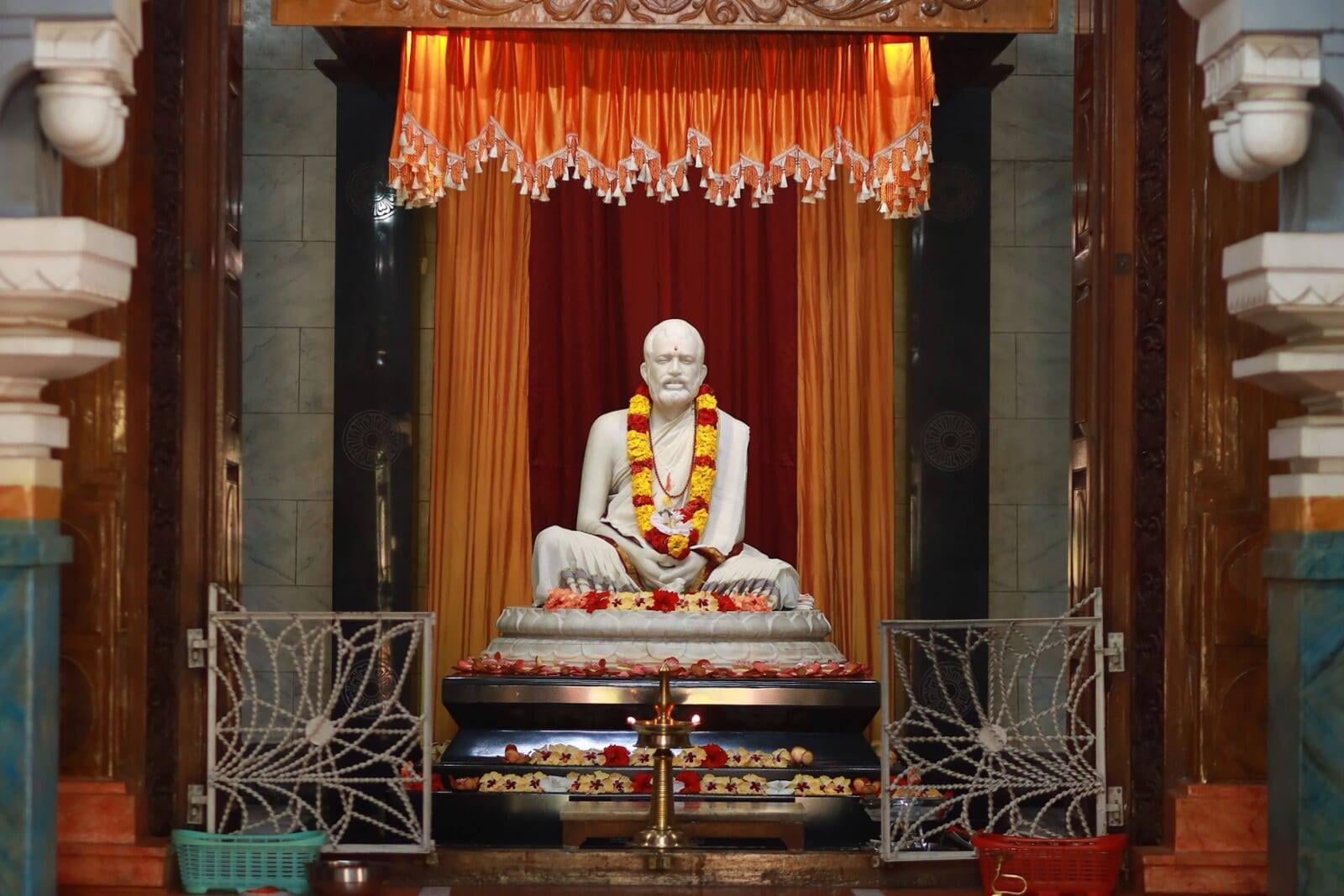
Swami Vivekananda in Thrissur
As part of his countrywide tour, Swami Vivekananda arrived at Mysore and Mysore Maharaja accorded him great reverence and royal treatment. After his sojourn at Mysore and bidding Mysore Maharaja adieu, Swami Vivekananda left for Kerala. He refused to accept any gift from the Maharaja except a train ticket that would take him to Thrissur in Kerala. It might have been his meeting with Dr. Palpu at Bangalore that prompted him to give up his earlier plan to leave for Kanyakumari via Rameswaram.
At Thrissur the Swami stayed only a few days. He next went to Kodungallur, a place famous as a seat of learning and for its Kali temple. At Kodungallur, people saw him sitting, early one morning, under a banyan tree near the Kali temple. The Swami tried to enter the temple to offer worship to the deity; but the temple guards prevented him. Without getting annoyed, he returned to the tree after bowing down to the Devi from outside. The nearest railway station for Thrissur was Shoranur; Swamiji alighted at Shoranur and travelled the twenty-one miles to Thrissur by bullock-cart. It is said that when the bullock-cart passed in front of the house of one D. A. Subramanya Iyer, an officer in the Education Department of Cochin State, Swamiji got down and asked Shri Iyer, who was standing at the door, whether there was any suitable place for bathing. Impressed by the Swami's personality, this gentleman provided him with facilities for a bath and then entertained him as a guest in an annexe to his house. Afterwards, Subramanya Iyer took him to the District Hospital run by the Government, where a Dr. De Souza treated him for sore throat.
His ochre robes and brilliant eyes attracted the attention of a young man, who approached him with the intention of having some fun; but the young man came away disappointed, when he found that the Swami was not as he had thought him to be.
Just then two princes of the Kodungallur palace - Kochunni Thampuran and Bhattan Thampuran - came to the temple, and the young man just mentioned brought them to the Swami sitting under the banyan tree. The two princes were well versed in the scriptures. They could see from the Swami's features that he was not an ordinary person. When they approached him, he asked them why he was not allowed to enter the temple. They replied that it was difficult to know the caste of people, especially of those who came from outside Kerala, and therefore there was this custom. They had an argument in Sanskrit over the issue. The Swami, however, did not want to interfere with their local tradition, even though the princes were later prepared to allow a person of his calibre to enter the temple. They argued with the Swami for two days, and were defeated. On the third day they approached the Swami with the desire to have his holy company. When they reached the place where he was, they found him meditating. They waited until he had finished. The glowing, calm appearance of the Swami reminded them of what the scriptures say about the man of meditation. After the Swami had come back to normal consciousness, he conversed with the princes in Sanskrit. When they took their leave, they made obeisance at his feet.
Then some of the learned women of the royal family came to meet the Swami and spoke with him in chaste Sanskrit. The Swami was surprised to find women speaking Sanskrit so fluently. In no other part of India had he come across this. No doubt he was delighted to do so now.
On the fourth day the princes again went to the temple; but they were disappointed when they did not find the Swami under the banyan tree. He had left the town and gone towards Cochin. Some months later, when they saw the picture of Swami Vivekananda in the papers and read about his success in the Parliament of Religions at Chicago, they recognized him to be the monk with whom they had spoken under the banyan tree. Only then did they come to know his name.
Brief History of Sri Ramakrishna Math, Puranattukara, Thrissur
Brief History of Sri Ramakrishna Math, Puranattukara, Thrissur
It is no small fortune to be the instrument in spreading the message of an Avatara, an Incarnation of God. This uncommon prospect is as enlightening to the transmitter as to the recipient because grace of God prompts both. Swami Vivekananda once wrote from America to a brother-disciple : “Whoever, at this great spiritual juncture, will stand up with a courageous heart and go on spreading from door to door, from village to village, his (Sri Ramakrishna’s) message, is alone my brother, and a son of his.” It was that rare privilege of disseminating the message in Kerala’s cultural capital that fell to the lot of Krishna Menon who later became Swami Tyagisananda.
In 1915, Sri Appan Thampuran, a senior member of the Royal Family of Kochi, led an enthusiastic group of people in forming Vivekodayam Samajam, a small social outfit centered at Thrissur to revive the Hindu society. In its inaugural year, the Samajam celebrated the 80th birthday of Sri Ramakrishna and its commemorating the subsequent birthday anniversary of Sri Ramakrishna was grander with public feeding and colourful procession in Thrissur town. The celebration was marked by the royal participation of Ramavarma Thampuran, the 9th prince of Kochi.
Beginning of Sri Ramakrishna Math at Thrissur
Beginning of Sri Ramakrishna Math at Thrissur
In 1927, Krishna Menon founded the Sri Ramakrishna Gurukulam at Puranattukara with two little girls belonged to the Vettuva community among the Harijans. Harijan boys followed suit and in course of time boys from other communities including Naboodiri also joined the Gurukulam. Thus a Gurukula Vidyamandiram for boys and Matru Mandiram for girls were formally inaugurated on 1st June, 1927 at Puranattukara. The plot where the Gurukulam situated was duly purchased in 1930.
It was then in 1929 that the Ramakrishna Order took over these welfare activities along with the land. The new branch was addressed as Sri Ramakrishna Math, Puranattukara, Vilangan, Thrissur. Soon after,Krishna Menon was initiated into the vows of Brahmacharya and named Brahmachari Akhandachaitanya. Later in 1932, he was initiated into Sannyasa and named Tyagisananda. Apparently we had reached a great height in the atmosphere, for the sky was a dead black, and the stars had ceased to twinkle. By the same illusion which lifts the horizon of the sea to the level of the spectator on a hillside, the sable cloud beneath was dished out, and the car seemed to float in the middle of an immense dark sphere, whose upper half was strewn with silver.
Important Activities of the Math
Important Activities of the Math
The Math began spiritual classes (Antaryogam) for aspirants and Srimad Swami Ranganathananda became instrumental in advancing similar activities at the Math.
The Gurukula Vidya Mandiram which started with first and second classes has now become a higher secondary school with more than 2000 students. An alumni association which has been active in the 86-year-old school has recently been revivified and given fresh impetus. Gurukulam hostel has now about 40 inmates belonging to classes from 5 to 10. The Math has built houses for hundreds of poor families at different times and still continues to contribute to underprivileged sections of society and destitute. Agriculture was another key area of activity which supplied with necessary farm products for the inmates.
Temple
Temple
All activities of the Math have been conducted as an offering to Sri Ramakrishna and it was in 1966 that a magnificent temple of Sri Ramakrishna was constructed at the Math. Built during the 100th birth anniversary celebrations of Swami Vivekananda, the temple with a cement statue of Sri Ramakrishna was inaugurated by Srimad Swami Vireswaranandaji Maharaj, the then President of Ramakrishna Math & Ramakrishna Mission. The cement statue was later replaced by a marble one contributed by Srimad Swami Ranganathanandaji Maharaj, the then President of Ramakrishna Order. The marble statue was consecrated by Srimad Swami Gahananandaji Maharaj, the then Vice-President.


